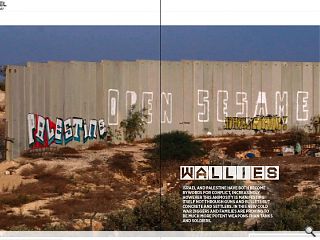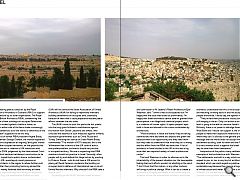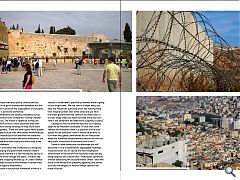Israel - Wallies
7 Aug 2014
Israel and Palestine have both become bywords for conflict, increasingly however this animosity is manifesting itself not through guns and bullets but concrete and settlers. In this new Cold War diggers and families are proving to be much more potent weapons than tanks and soldiers.
Brainchild of former RIBA president Angela Brady and joint member George Oldham, the motion registered the professions displeasure at ongoing ‘land grab’ moves by Israel in the occupied territories, on the grounds that Israel’s actions are in violation of UN resolutions and contravene a 2004 judgement by the International Court of Justice which declared settlement construction to be illegal. They hoped that a public stance, orchestrated through the UIA, would apply moral pressure on ‘culpable’ architects in the region to refuse further such work but rather than promoting harmony abroad the gesture has merely fostered fresh acrimony at home.
All of this was seemingly for nothing as, despite all this fire and fury, the International Architects Union (UIA) will not censure the Israel Association of United Architects (IAUA) for failing to reprimand members building settlements on occupied land, ostensibly because of fears that it could jeopardise nascent peace efforts between the two sides.
The IAUA’s move to punt this particular hot potato into the long grass followed a mobilisation against the motion from Daniel Liebskind and others, who criticised the absence of such measures against similarly repressive governments such as China, Russia and Turkey. Defending her stance on Urban Realm Brady commented: “This motion is NOT a boycott, this is the ‘affirmation that in terms of the UIA code of ethics and professionalism, architects should not practice in occupied territory.’ No one is requesting that RIBA members should not practice in Israel. Secondly, often people will try and defend this illegal action by pointing to China or Russia - who do not have a UIA accord in place yet! David Cameron condemns the building on occupied land in defiance of International Law so do all United Nations members. Why shouldn’t the RIBA take a stance too?”
Expanding on the IAUA’s decision Israeli architect and contributor to Al Jazeera’s Rebel Architecture Eyal Weizman, said: “I think it was to be expected but I’m happy that the issue was raised so prominently. I’m happy that Israeli architects cannot take for granted their participation in an illegal and unethical project which is in violation of human rights. It opens people’s eyes both in Israel and abroad to the crimes undertaken by architecture.
“Most architects in Israel are liberal, they are taking commissions here and there and beyond the green line because there is an opportunity and they need work - but they need to understand that what they do is wrong and this effort from the RIBA has done that. A lot of architects in Israel studied in the UK so this was a big issue that was reported widely in Israeli architectural circles.”
That said Weizman is under no allusions as to the intractability of the present situation nor the inescapable feeling that such efforts are akin to whistling in the wind: “I don’t think that this motion, or any other motions, will bring in political change. What it can do is create is a process of bringing awareness of de-normalising the situation so that the international architects and Israeli architects understand that this is not acceptable. People are watching, thinking about it and not accepting it. Many people worldwide, I would say, are against that.
“They’ve had their procedural victory but the issue is still hanging in the air. Only civil action at an international level is going to be able to convince Israeli’s to change. Militarily, there is no power to dislodge Israel from the West Bank and I would not support it, the only way is for people to make their objections heard and take action where they can. It all adds to the general pressure and message that the world does not accept their part in settlement building, both for them and the Palestinians. It is not a motion which is against the Israeli people; it is a way to save them from themselves.”
Irrespective of the politics many settlements are examples of bad architecture with Weizman observing: “The settlements are built in a way which would not appeal to you, or me, or any kind of architectural standard which we could regard as positive in any sustainable way because they require a huge amount of infrastructure and water. But the aim is obviously different; it’s low-density to take as much land as possible in the quickest time. A lot of the buildings are ad-hoc and improvised and quickly constructed but others are built to good architectural standards but this is not a reason to sanction the organisation of architects, this problem is pervasive worldwide.”
“They (settlements) are usually completed by big mainstream construction companies, making a tender for construction. The model is repetitive so they are building say 800 units in a more suburban area with mid-rise or multi-storey buildings or they could build houses and gardens. There are other types where people are encouraged to build their own homes where they get the plot and infrastructure for free from the state and then they employ an architect and build themselves, but this is far slower and more costly and exists only in the wealthier settlements.
“In settler colonialism the architecture is doing two things; it is helping the government transfer citizens into an occupied area and it is also limiting the ability of Palestinians to move through the space - because the settlements are chopping the area up. It’s slow violence in the sense that the entire environment is transformed into a weapon against Palestinians.
“The question is the political framework in which a solution is undertaken, specifically whether there is going to be a single state.. We live now in a single state, you have the Palestinian authority which has nothing more than mayoral powers over some cities and you have the Israeli government that controls the wider area. In a (true) single state you make sure that everyone has a vote in the parliament and that there is equality in place.”
Casting his mind to what the future of such spaces ought to be Weizman concluded: “In case that some settlers are evacuated there is a question of how such spaces will be used and I think it would be an error to turn them into gated communities for the Palestinian elites and therefore the settlements should turn into the new public institutions of university and clinics.”
Travel to Israel today and the landscape you will encounter is one of settlements, segregated roadways, industrial zones and of course the wall, the physical embodiment of the schism that fractures Israeli society along religious and cultural lines. Treating the symptoms without addressing the cause ferments unrest – and with much of the Middle East presently agitating over similar divisions the dangers of inaction weigh heavier than those of action.
|
|
Read next: Rural Mural - Colouring Opinion
Read previous: Landscape - Park Life
Back to August 2014
Browse Features Archive
Search
News
For more news from the industry visit our News section.
Features & Reports
For more information from the industry visit our Features & Reports section.





